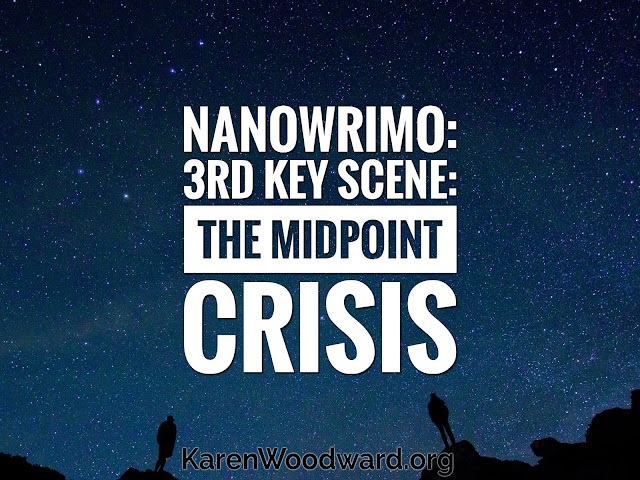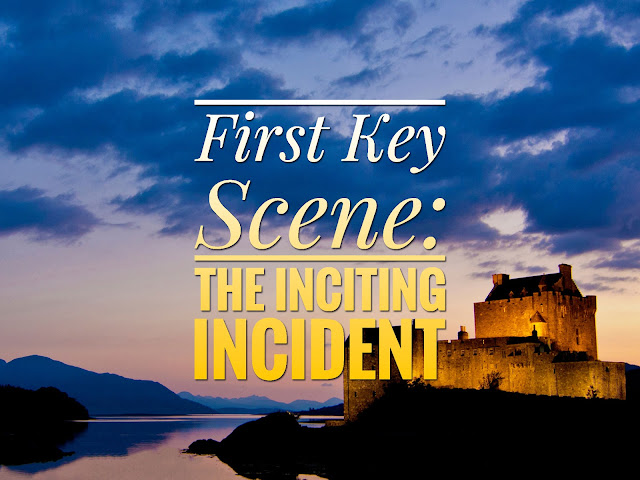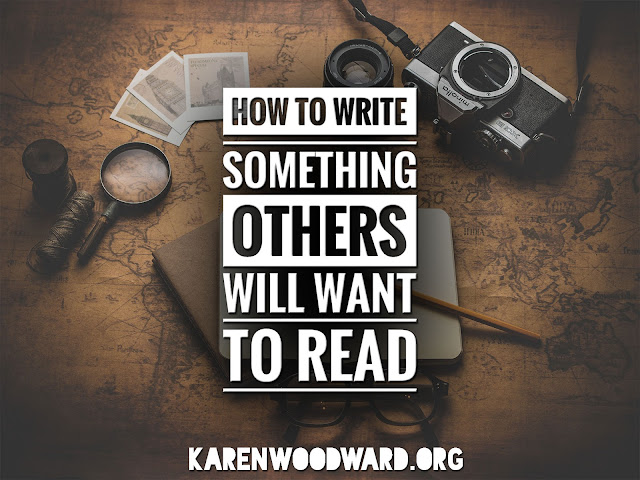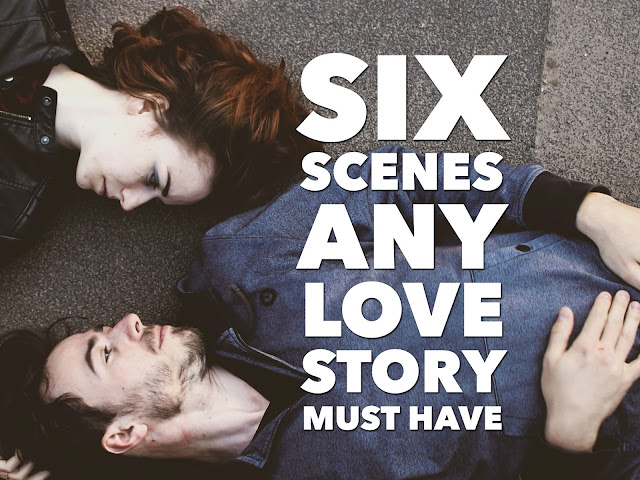People on the outside think there’s something magical about writing, that you go up in the attic at midnight and cast the bones and come down in the morning with a story, but it isn’t like that. You sit in back of the typewriter and you work, and that’s all there is to it. —Harlan Ellison
Today I’m going to talk about the Lock-In. Before I say more about this scene, though, I’d like to talk about something else.
A Clarification: What I Mean by “Key Scene”
What follows is my take on this, you might not agree with me and that’s fine. That’s great! How boring would it be if we all agreed?
I’ve been saying that the key scenes I’ve been blogging about are scenes that any narrative story will have either onstage or offstage.[3] Let me clarify what I mean by this.
Sometimes people write to me and say, “Karen, you’re wrong! One of my favorite authors, Jane Doe, has written a best selling novel and she’s never even heard of a story climax!”
Folks have been creating stories for millennia but many of the terms, the words, we use to describe elements of these stories are of recent invention. That’s okay. Things don’t come labeled with names. The Grand Canyon could have been called something else!
Just because a writer doesn’t know the term “story climax” doesn’t mean the stories they’ve written are devoid of a climax. If the book is selling well, I guarantee you it’s there!
Every well-formed narrative story has a climax, a moment, where the final conflict, the final confrontation, between the protagonist and the antagonistic force is played out and only one of them leaves victorious (or they could both lose). Maybe this scene isn’t written down on the page, maybe it is one of those stories I hate where the climax is gestured to offstage. But all narrative stories have one.
Similarly, at some point in any narrative story there will be a place where the protagonist is locked into her quest. She’s committed. There’s no going back.
This is true of all the narrative works I’ve read or watched. That said, there are non-narrative, non-representational works I’ve read/viewed that this isn’t true of. But what I’m talking about here are the kind of stories that have been told around campfires for millennia, the kind of stories children beg their parents to tell them before bed: stories told with the intention of entertaining an audience.
Plot Point One: The Lock-In: Breaking It Down
The idea of a plot point was introduced by Syd Field in his eminently readable book, Screenplay. It’s the idea of a significant event, a complication, that spins the action of the story around in a radically different direction.
According to Field there are only two plot points, one at the end of Act One (The Lock-In) and another at the end of Act Two (The All Hope is Lost Point[2]). Other folks like working with a system in which there are four plot points, four scenes that spin the action of the novel in a different direction: the Lock-In, the Midpoint Crisis, the All Hope is Lost point and the Climax. That’s fine too!
What is it?
This complication has the effect of locking the protagonist into her quest.
One of my favorite examples of a lock-in occurs in the Matrix when Morpheus gives Neo a choice: take the red pill and learn the truth he has been searching for all his life, the truth about the Matrix, or take the blue pill and continue life as before. Whichever choice Neo makes, there’s no going back.
In Star Wars IV: A New Hope when Luke finds his aunt and uncle dead, murdered by storm troopers, he understands there’s no going back. His ordinary world is gone.
Key points:
- The Lock-In should be be a clear point of no return. That said, sometimes this transition is figurative. Sometimes one character says to another, “If you do this, there’s no going back.” Perhaps that is a bit on the nose, but it does the job.
- There needs be be a complication, a twist. The action of this scene needs to push the main plot in a different direction.
Where is it?
The Lock-In occurs at the end of Act One. In practice I’ve found that it can come anywhere from 25% to 30% of the way through a story.[4]
How is the Lock-In connected to the protagonist’s desires?
The protagonist's desires—internal and external—set the protagonist's goal. It is that goal that the protagonist is now committed to achieving.
Stepping Through an Example
I’m going to use Star Wars IV: A New Hope as my example.
Is this a point of no return? Yes. Luke’s aunt and uncle are dead. The farm has been destroyed. Luke cannot go back to his old life.
Is there a complication, a twist? Yes, and for the same reason. Because Luke’s aunt and uncle are dead his entire world has changed, his life has just gained a new direction. Luke doesn't even think about the academy anymore, his goal now is to aid the resistance.
How The Lock-In Is Implemented in Three Genres: Action, Romance & Mystery
I’ve found that during the Lock-In, regardless of genre, there is often some banter, a moment of bonding, between the protagonist and one of her companions (most likely a helper/sidekick).
Action Genre
We’ve just taken a look at Star Wars IV: A New Hope, so I won’t go over those points again here. One of my favorite Lock-In scenes is from Edge of Tomorrow where not only is Cage stripped of his rank as officer and made to join the cadets on the front line, but his fellow soldiers are told that he has been caught impersonating an officer!
Romance Genre
The central tension in a romance is whether the antagonist and protagonist (the lovers) will bond with each other. The exact form this bond takes depends on the sub-genre.
The Lock-In often coincides with the Confession of Love. Depending on how that goes the lovers may break up or possibly have their first kiss—or at least a significant kiss. It could be that their first kiss was more or less humdrum. If that’s the case then this kiss will blow their socks off!
See: 6 Scenes Any Love Story Must Have
Murder Mystery Genre
I’ve found—and here I’m drawing on my own personal experience as an avid consumer of mystery stories—that often a major clue is given at the Lock-In, something that transforms the second victim’s life and acts as a Point of No Return for that character.
Also, often, a second body is found at the Lock-In, something that spins the investigation off in a new direction. In this case, the second body is the clue.
Every post I pick a book or audiobook I love and recommend it to my readers. This serves two purposes. I want to share what I’ve loved with you, and, if you click the link and buy anything over at Amazon within the next 24 hours, Amazon puts a few cents in my tip jar at no cost to you. So, if you click the link, thank you! If not, that’s okay too. I’m thrilled and honored you’ve visited my blog and read my post. :-)
I know it looks a bit like a textbook, but don't be put off! This is a wonderful reference: Scene & Structure by Jack M. Bickham. I've read this book cover to cover and it helped me enormously, especially when it comes to understanding sequels and the logical order of story events. Cheers!
That’s it for today! I’ll talk to you again tomorrow, but I might take a break from writing about key scenes.
How is NaNoWriMo going for you folks? Please share! :-)
Word count so far: 6,778
Word count for today: 1,500 non-fiction + 790 fiction = 2,290
Total words this month: 9,008
Notes:
1. I say every narrative story ever written because some stories are not representational.
2. Another name for this is the Major Setback.
3. If a scene occurs “onstage” then the narrator tells us about it. If a scene occurs “offstage” then we hear about it indirectly. Another character might talk about it or perhaps the viewpoint character will have a flashback.
4. Screenwriters will know exactly which page a key scene should fall on, but its position in a novel is less precise. That said, if you want your story to be easy to turn into a movie, it wouldn’t hurt to have the Lock-In at between 25% and 30%.









